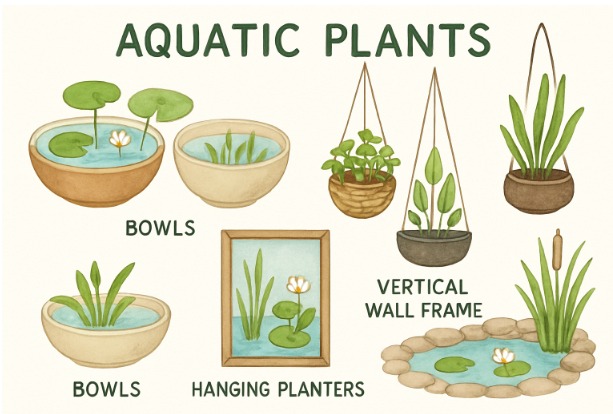Table of Contents
- Introduction
- Indoor Water Gardens
- Vertical Aquatic Gardens
- Aquatic Plant Wall Art
- Community Ponds and Water Features
- Floating Islands in Urban Ponds
- Aquaponic Systems for Sustainable Living
- Educational Aquatic Plant Displays
- Restoring Aquatic Plants in Architecture
Integrating aquatic plants into home and community environments brings beauty, tranquility, and sustainability to otherwise ordinary places. Whether creating a relaxing indoor retreat or enhancing a shared neighborhood area, these vibrant, water-loving species bring new possibilities for biophilic design. Aquatic pond plants not only elevate aesthetics but also provide advantages for wellness, environmental quality, and local biodiversity. Innovative use of aquatic plants can transform indoor rooms and common outdoor spaces with minimal maintenance and maximum ecological benefit. Their versatility and resilience make them ideal choices for creative projects in homes, offices, parks, and public buildings
Indoor Water Gardens
Even small homes and apartments can be transformed by placing aquatic plants in glass vases, bowls, or compact aquariums. Species like anubias, water lilies, and lotus are easy to grow indoors and offer a peaceful, meditative vibe. With the right containers, you can add a touch of moving water and greenery to shelves, windowsills, or centerpiece displays. These water gardens purify the air, increase humidity, and create a focal point that soothes and inspires. For step-by-step guides and inspiration, DIY indoor water garden ideas are a great place to begin.
Vertical Aquatic Gardens
Limited floor space doesn’t mean giving up on greenery. Vertical aquatic gardens, made from stacked planters, wall-mounted modules, or custom hydroponic frames, bring living art to eye level. These installations work in homes, offices, or urban lobbies—anywhere you’d like to add visual interest and hear the gentle trickle of water. Not only do these gardens make impressive statements, but they also filter indoor air and encourage moments of calm, especially in bustling city environments.
Aquatic Plant Wall Art
Integrating aquatic plants into artful displays can transform plain walls into living masterpieces. Shadow boxes, open glass frames, or recessed wall niches filled with small aquatic or air plants create a dynamic and ever-evolving texture. This method adds both a sculptural and organic element to interiors, enabling biophilic design without occupying floor space. These living walls change with the seasons and can easily be updated to match evolving interior styles.
Community Ponds and Water Features
Aquatic planting can revitalize parks, courtyards, and plazas. Community ponds enriched with native water hyacinths, water irises, or pickerelweed not only become neighborhood landmarks but enhance ecological health by stabilizing shorelines and filtering runoff. Well-designed water features invite gatherings, support urban wildlife, and encourage stewardship of public green spaces. Maintenance is manageable with thoughtful layout and community involvement, ensuring longevity and year-round appeal.
Floating Islands in Urban Ponds
Floating islands are an innovative solution to urban water quality and biodiversity challenges. Planted with a mix of native aquatic plants, these mobile ecosystems naturally filter pollutants, absorb nutrients, and create shelter for birds, insects, and fish. Once established, floating islands require minimal intervention and add visual intrigue to urban ponds or stormwater basins. Cities such as Chicago and Singapore have embraced these solutions to boost local ecology and beautify high-traffic areas.
Aquaponic Systems for Sustainable Living
Aquaponics merges fish cultivation with hydroponic plant growth, creating a closed-loop ecosystem that produces both fresh vegetables and fish. These systems are rapidly growing in popularity for their low water use, efficient food production, and engaging educational opportunities. At home, small-scale aquaponic tanks can fit on kitchen counters or patios; in communities, larger set-ups serve as teaching gardens and food sources. Aquaponic initiatives foster awareness of sustainable agriculture and ecological cycles, paving the way for greener living.
Educational Aquatic Plant Displays
Schools, libraries, and nature centers benefit from interactive aquatic plant exhibits. These displays, ranging from desktop aquariums to outdoor demonstration wetlands, immerse visitors in the diversity and value of aquatic plants. Hands-on learning activities promote environmental literacy, spark curiosity, and cultivate a sense of responsibility toward water stewardship and conservation. Creative educators use these setups as springboards for lessons in biology, ecology, and art.
Restoring Aquatic Plants in Architecture
Historical and modern buildings alike are turning to aquatic plants to blend ecological restoration with architectural design. Projects like the restoration of the Mies van der Rohe Pavilion’s reflecting pools demonstrate how these initiatives can merge aesthetic vision with environmental integrity—enhancing building cooling, supporting native wildlife, and reviving lost landscapes. Design teams increasingly collaborate with ecologists to ensure successful integration of aquatic plants, setting new standards for sustainable development.

